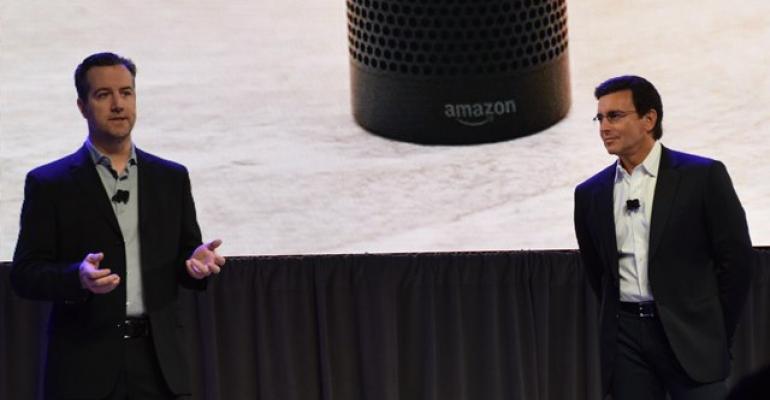LAS VEGAS – Eager to own the space for connected vehicles, Ford kicks off another year here at CES with several techy initiatives, such as high-speed onboard Internet access, enabling drones to work with rescue vehicles in emergency situations and tripling (to 30) the number of highly autonomous research vehicles.
In addition, Ford is developing links between millions of SYNC-equipped vehicles and Amazon Echo so consumers, from behind the steering wheel, can control lights, thermostats, security systems and other features of their homes.
Likewise, Ford says its SYNC Connect system, working with the Amazon Echo personal assistant in the home, will let consumers stop, start, lock, unlock and check their vehicle’s fuel range from the comfort of their living rooms.
Introduced last year, Amazon Echo is a hands-free speaker controlled wirelessly and was one of Amazon’s top-selling products this past holiday season. It interfaces with Alexa, the cloud-based brain, much like Apple’s Siri.
“If you want to play your favorite music, find sports scores, get weather or traffic or check your calendar, just ask, even from across the room and while music is playing,” Greg Hart, vice president-Amazon Echo, says during a press conference hosted by Ford CEO Mark Fields.
“Echo can also control smartphone devices, prepping your home for your arrival,” Hart says. “Thanks to our work with Ford, we’re looking at ways Alexa can connect to your vehicle.”
Fields and Hart demonstrate the technology onstage by giving several voice commands, such as “Ask MyFord to start” or “Please ask MyFord to check the battery status in my C-Max.”
In each case, a pleasant female voice says the commands have been executed.
“Your vehicle currently has electric range of 19 miles (31 km) and gasoline range of 507 miles (816 km), with a total range of 526 miles (846 km),” Alexa says during the press conference.
Fields also demonstrates the ability to have Alexa turn on the kitchen lights or the television and open the garage door for a Ford vehicle owner arriving home.
“My favorite is, ‘Alexa, make my kids disappear,’” Fields says with a smile. “But we haven’t quite gotten to that point yet.”
Ford plans to offer the technology to vehicle owners later this year and is demonstrating it at its booth here during the massive electronics convention, attended by more than 160,000 people.
50 Billion Connected Devices by 2020
Fields says the point is to make people’s lives better, and the automaker’s third-generation voice-activated SYNC infotainment system, rolled out in late 2015 in place of a troubled second-generation offering, is achieving record high levels of customer satisfaction.
“By 2020, we expect more than 43 million vehicles on the road with SYNC, helping drivers stay connected on the move while keeping their hands on the wheel and their eyes on the road,” he says.
Further improving on SYNC 3 connectivity, Ford announces the availability of Apple CarPlay and Android Auto on all ’17 models equipped with SYNC 3, starting with the new Escape. Owners of ’16 models with SYNC 3 can upgrade their systems later this year to add the technologies, Fields says.
Also new is SYNC Connect technology, powered by 4G LTE to enable remote start, unlocking of doors, checking fuel level and locating a parked vehicle via smartphone.
“We’re also making it easier for app developers to offer even more personalized experiences through AppLink,” Fields says. “Everything from helping customers to map their journeys to finding nearby entertainment and automatic tracking mileage for expense reports, all on the move.”
Finally, Fields says Ford is “exploring new ways to connect our vehicles to work even harder, such as helping people affected by natural disasters.” The project ties Ford researchers in Silicon Valley working with drone maker DJI.
The two parties have launched the DJI Developer Challenge to create smart drone-to-vehicle software for a rapidly deployable surveying system for use by the United Nations in emergency zones. Future applications could include agriculture, forestry, construction and bridge inspection.
All of these technologies tie into the Internet of Things, which Fields describes as “connecting the online world with our physical world.”
By 2020, he says the number of Internet-connected devices could reach up to 50 billion.





